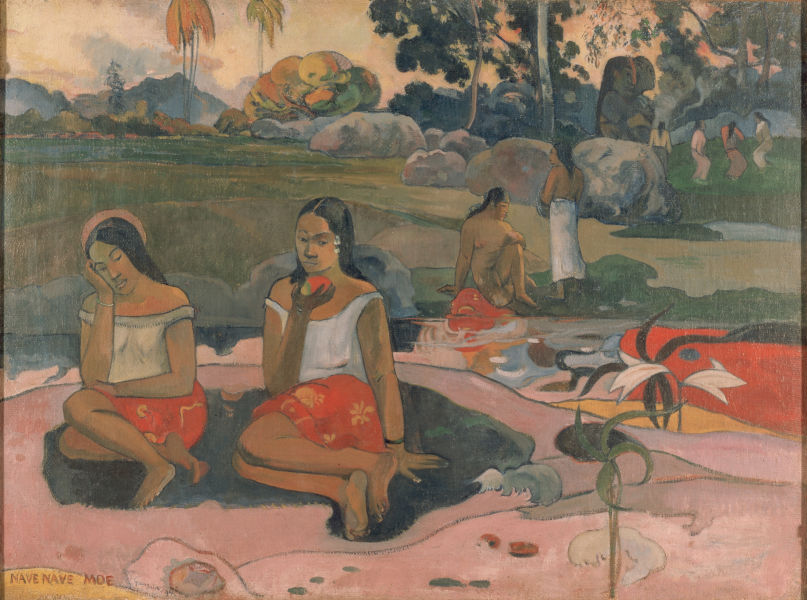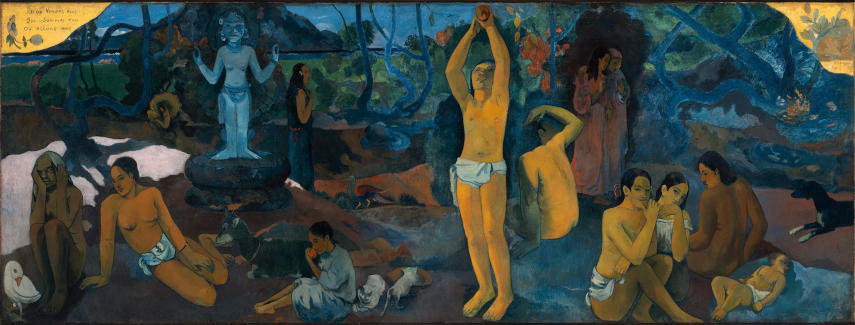Gauguin's Tahiti - Questioning a Troubling Legacy
In recent decades, numerous exhibitions focusing on Paul Gauguin and his work have been staged, including the Gauguin: Artist as Alchemist exhibition at the Art Institute of Chicago, retrospectives at the National Gallery of Art in Washington and Tate Modern in London, and the more recent the Gauguin Portraits exhibition at the National Gallery in London.
These shows tried to re-evaluate the artist's oeuvre in light of the shifting public attitudes, recently actualized through MeToo and Black Lives Matter movements. While Gauguin undoubtedly broke many contemporary social norms, he is, nonetheless, celebrated for his contribution to modern art and culture, and his highly original visual language.
His transgressions are mainly linked to his Polynesian years; after leaving his wife and children in Paris, Gauguin moved from France to French Polynesia, where he 'married' a local underaged girl with whom he had a child. In addition to depicting this world as unaffected by colonial violence, he also used the language of the colonialists in describing the locals, with terms such as 'exotic,' 'meek' and 'fool' appearing in his writings.
Is it time to stop looking at Gauguin altogether? – asked a voice on the audio guide of the Gauguin Portraits exhibition in London. While his legacy remains strong in art history, Gauguin's Tahitian years cast a long shadow over his artistic achievements.

Before Tahiti - A Search for New Inspirations
"I will take my paint and my brushes," Gauguin wrote to his wife Mette-Sophie in 1887, and "live like a native." He urged her to come to Paris from Denmark, where she was staying with four of their children, and collect their fifth child. Soon after, Gauguin would leave for Panama with his fellow painter Charles Laval, but finding the country inhospitable, the pair would move to the Caribbean island of Martinique instead.
This period of Gauguin's exploits is less known than his later stay on the French Polynesian island of Tahiti but is nonetheless crucial for the formation of his artistic ideas and development of his style. The travel also profoundly changed his self-awareness; as he told the French art critic Charles Morice in 1890, he had "a decisive experience in Martinique."
"It was only there that I felt like my real self, and one must look for me in the works I brought back from there, rather than those from Brittany, if one wants to know who I am."
The images from Martinique show large, powerful figures, mainly women, domineering the scenery that appears "lyrical and delicate and hazy and scenic," says Karen Rechnitzer Pope, a professor of 19th-century European art. From that time on, this approach would prevail in his work, explains the professor.
Martinique was a profound inspiration for Paul Gauguin, who was struggling with his personal and professional life in Paris. Not able to make enough money as his paintings fell out of favour, complaining about the lack of aesthetic inspiration, and forced out from the family home by his wife (whom he abused), he decided to continue his explorations of remote islands in the hope that it would refresh his career and bring a new period in his life. In 1891 he set sails for Tahiti, where he would, with intermissions, spend the next decade.

Paul Gauguin's Tahiti
"I stand at the edge of the abyss, yet I do not fall in," wrote Gauguin to a friend before he left.
The travel was also a carefully orchestrated marketing stunt that was supposed to raise interest in his work and reignite his career. He held a banquet in Paris for the intellectual elite of the time, talking about the revival of his art among the 'exotic' and 'savage.'
Leaving on a high note, the French artist was flabbergasted by what awaited him after he arrived. The society was changed; the paradise he expected was maimed by the violence of colonial rule, forcing Gauguin to travel to rural areas in search of the 'exotic,' 'savage,' and mysterious culture he craved.
He moved to the district of Mataiea, on the far west side of the island, where he would meet his Tahitian muse, Teha'amana, who would be the main protagonist in many of his paintings. She became his 'native' wife at the age of 13 — a practice commonly taken by French colonialists — although the 'marriage' was not legally binding and was often made by the family to enhance its social and economic status.
His early works from Tahiti show the Catholic iconography transposed into the South Pacific. For example, the La Orana Maria (Salve, Maria) painting depicts Polynesian natives in the roles of the Madonna, the angel, and the child. However, such explorations will soon be substituted with images centered on local traditions. In the famous Manao tupapau (The spirit of the dead watches you), the naked girl (Teha'amana) is accompanied by the ghost of the dead.
In 1892, Gauguin became seriously ill and was forced to return to Paris to receive medical care. However, this interlude only strengthened his belief that he should return.
"What a stupid way of life, the European way of life!" — he exclaimed before leaving Europe, never to return again.

Falling for a Myth
A couple of decades ago, Gauguin's paintings from Tahiti would have attracted attention for its formal innovation; however, public sensitivity to issues of race, colonialism, and gender has changed in recent decades, meaning that his paintings has been reassessed in new light.
Amelia Hill from Guardian describes Gauguin as "a sadist who battered his wife, exploited his friends, and lied to the world about the erotic Eden he claimed to have discovered on the South Sea island of Tahiti." The findings, condensed in the book Paul Gauguin, An Erotic Life, by Nancy Mowll Mathews, shed a new life on his life and work.
"The island is virtually unrecognisable in his representations, carefully calculated to intrigue the French audience," Mowll Mathews writes, "Gauguin seems to have fallen for the myth of Tahiti he created. He returned expecting the erotic idyll that was only ever a figment of his imagination. Of course, he didn't find it and the disappointment was profound: he died a twisted and bitter man, having alienated everyone both at home and in Tahiti."
It's a sad story of a man who believed his own fiction.
Sensing his own death, Gauguin left Tahiti and settled in the Marquesas Islands, where he died in 1903.
What can be made of Gauguin's Tahiti years? A middle-aged artist in search of redemption and revival of his artistic career forged, in his imagination, an idyllic and exotic place where his life could be revitalized, where social norms of the West were not stifling life, and where he could express himself freely, regardless of the morality of it.
"I want to end my life here, in the solitude of my shack. Oh yes, here I am a criminal, but… what is wrong with that? Michelangelo was also a criminal."
Featured image: Paul Gauguin - Mahana no atua (Day of the God), 1894, via Creative Commons
Can We Help?
Have a question or a technical issue? Want to learn more about our services to art dealers? Let us know and you'll hear from us within the next 24 hours.
